Evaluating the Role of the EOF Analysis in 4DEnVar Methods
Abstract
:1. Introduction
2. Mathematical Formulations
2.1. The DRP-4DVar and the 4DEnVar Methods
2.2. The ETKF
2.3. Comparison among the DRP-4DVar, the 4DEnVar, and the ETKF Methods
3. Experiment Design
4. Experimental Results
5. Summary and Conclusions
Acknowledgments
Author Contributions
Conflicts of Interest
References
- Courtier, P.; Thépaut, J.N.; Hollingsworth, A. A strategy for operational implementation of 4DVar, using an incremental approach. Q. J. R. Meteorol. Soc. 1994, 120, 1367–1387. [Google Scholar] [CrossRef]
- Evensen, G. Sequential data assimilation with a nonlinear quasi-geostrophic model using Monte Carlo methods to forecast error statistics. J. Geophys. Res. 1994, 99, 10143–10162. [Google Scholar] [CrossRef]
- Lorenc, A.C. The potential of the ensemble Kalman filter for NWP—A comparison with 4D-Var. Q. J. R. Meteorol. Soc. 2003, 129, 3183–3203. [Google Scholar] [CrossRef]
- Kalnay, E.; Li, H.; Miyoshi, T.; Ballabrera, J. 4DVar or ensemble Kalman filter? Tellus A 2007, 59, 758–773. [Google Scholar] [CrossRef]
- Gustafsson, N. Discussion on “4DVar or EnKF?”. Tellus A 2007, 59, 774–777. [Google Scholar] [CrossRef]
- Caya, A.; Sun, J.; Snyder, C. A comparison between the 4DVar and the ensemble Kalman filter techniques for radar data assimilation. Mon. Wea. Rev. 2005, 133, 3081–3094. [Google Scholar] [CrossRef]
- Yang, S.C.; Corazza, M.; Carrassi, A.; Kalnay, E.; Miyoshi, T. Comparison of local ensemble transform Kalman filter, 3DVAR, and 4DVar in a quasigeostrophic model. Mon. Wea. Rev. 2009, 137, 693–709. [Google Scholar] [CrossRef]
- Buehner, M.; Houtekamer, P.L.; Charette, C.; Mitchell, H.L.; He, B. Intercomparison of variational data assimilation and the ensemble Kalman filter for global deterministic NWP. Part I: Description and single-observation experiments. Mon. Wea. Rev. 2010, 138, 1550–1566. [Google Scholar] [CrossRef]
- Buehner, M.; Houtekamer, P.L.; Charette, C.; Mitchell, H.L.; He, B. Intercomparison of variational data assimilation and the ensemble Kalman filter for global deterministic NWP. Part II: One-month experiments with real observations. Mon. Wea. Rev. 2010, 138, 1567–1586. [Google Scholar] [CrossRef]
- Poterjoy, J.; Zhang, F.Q. Inter-comparison and coupling of ensemble and variational data assimilation approaches for the analysis and forecasting of Hurricane Karl (2010). Mon. Wea. Rev. 2014, 142, 3347–3364. [Google Scholar] [CrossRef]
- Miyoshi, T.; Sato, Y.; Kadowaki, T. Ensemble Kalman filter and 4D-Var intercomparison with the Japanese operational global analysis and prediction system. Mon. Wea. Rev. 2010, 138, 2846–2866. [Google Scholar] [CrossRef]
- Skachko, S.; Errera, Q.; Chabrillat, S.; Ménard, R.; Christophe, Y. Comparison of EnKF and 4DVar methods in the context of stratospheric chemistry data assimilation. In Proceedings of the EGU General Assembly Conference Abstracts, Vienna, Austria, 7–12 April 2013. [Google Scholar]
- Fairbairn, D.; Pring, S.R.; Lorenc, A.C.; Roulstone, I. A comparison of 4DVar with ensemble data assimilation methods. Q. J. R. Meteorol. Soc. 2013, 140, 281–294. [Google Scholar] [CrossRef]
- Evensen, G.; van Leeuwen, P.J. An ensemble Kalman smoother for nonlinear dynamics. Mon. Wea. Rev. 2000, 128, 1852–1867. [Google Scholar] [CrossRef]
- Hunt, B.R.; Kalnay, E.; Kostelich, E.J.; Ott, E.; Patil, D.J.; Sauer, T.; Szunyogh, I.; Yorke, J.A.; Zimin, A.V. Four-dimensional ensemble Kalman filtering. Tellus A 2004, 56, 273–277. [Google Scholar] [CrossRef]
- Fertig, E.J.; Harlim, J.; Hunt, B.R. A comparative study of 4D-VAR and a 4D ensemble Kalman filter: Perfect model simulations with Lorenz-96. Tellus A 2007, 59, 96–100. [Google Scholar] [CrossRef]
- Buehner, M. Ensemble-derived stationary and flow-dependent background-error covariances: Evaluation in a quasi-operational NWP setting. Q. J. R. Meteorol. Soc. 2005, 131, 1013–1043. [Google Scholar] [CrossRef]
- Zhang, F.; Zhang, M.; Hansen, J.A. Coupling ensemble Kalman filter with four-dimensional variational data assimilation. Adv. Atmos. Sci. 2009, 26, 1–8. [Google Scholar] [CrossRef]
- Lorenc, A.C.; Bowler, N.E.; Clayton, A.M.; Pring, S.R. Comparison of Hybrid-4DEnVar and Hybrid-4DVar Data Assimilation Methods for Global NWP. Mon. Wea. Rev. 2015, 143, 212–229. [Google Scholar] [CrossRef]
- Qiu, C.J.; Shao, A.M.; Xu, Q.; Wei, L. Fitting model fields to observations by using singular value decomposition: An ensemble-based 4DVar approach. J. Geophys. Res. 2007, 112, D11105. [Google Scholar] [CrossRef]
- Golub, G.H.; van Loan, C.F. Matrix Computations, 4th ed.; The Johns Hopkins University Press: Baltimore, MD, USA, 2013; pp. 210–260. ISBN 978-1421407944. [Google Scholar]
- Liu, C.S.; Xiao, Q.N.; Wang, B. An ensemble-based four-dimensional variational data assimilation scheme. Part I: Technical formulation and preliminary test. Mon. Wea. Rev. 2008, 136, 3363–3373. [Google Scholar] [CrossRef]
- Liu, C.S.; Xiao, Q.N.; Wang, B. An ensemble-based four-dimensional variational data assimilation scheme. Part II: Observing system simulation experiments with Advanced Research WRF (ARW). Mon. Wea. Rev. 2009, 137, 1687–1704. [Google Scholar] [CrossRef]
- Tian, X.J.; Xie, Z.H.; Dai, A.G. An ensemble-based explicit four-dimensional variational assimilation method. J. Geophys. Res. 2008, 113, D21124. [Google Scholar] [CrossRef]
- Tian, X.J.; Xie, Z.H.; Sun, Q. A POD based ensemble four-dimensional variational assimilation method. Tellus A 2011, 63, 805–816. [Google Scholar] [CrossRef]
- Zhang, B.; Tian, X.J.; Sun, H.J.; Chen, F.; Zhang, Y.C.; Zhang, L.F.; Fu, S.M. PODEn4DVar-based radar data assimilation scheme: Formulation and preliminary results from real-data experiments with advanced research WRF (ARW). Tellus A 2015, 67, 26045. [Google Scholar] [CrossRef]
- Tian, X.J.; Xie, Z.H.; Liu, Y.; Cai, Z.N.; Fu, Y.; Zhang, H.; Feng, L. A joint data assimilation system (Tan-Tracker) to simultaneously estimate surface CO2 fluxes and 3-D atmospheric CO2 concentrations from observations. Atmos. Chem. Phys. 2014, 14, 13281–13293. [Google Scholar] [CrossRef]
- Stefanescu, R.; Sandu, A.; Navon, I.M. POD/DEIM Reduced-Order Strategies for efficient four dimensional variational data assimilation. J. Comput. Phys. 2015, 295, 569–595. [Google Scholar] [CrossRef]
- Altaf, M.U.; Ambrozic, M.; McCabe, M.F.; Hoteit, I. A study of reduced-order 4DVAR with a finite element shallow water model. Int. J. Numer. Method. Fluids 2016, 80, 631–647. [Google Scholar] [CrossRef]
- Ambrozic, M. A Study of Reduced Order 4D-VAR with a Finite Element Shallow Water Model. Master’s Thesis, Delft University of Technology Faculty of Electrical Engineering, Delft, The Netherlands, 19 November 2013. [Google Scholar]
- Tissot, G.; Cordier, L.; Benard, N.; Noack, B.R. 4D-Variational Data Assimilation for Pod Reduced-Order Models. Available online: http://www.dl.begellhouse.com/references/3ce1b491115b5c16,15f13bde2c0586bc,68fd7b9c15cacc0a.html (accessed on 30 August 2013).
- Tissot, G.; Cordier, L.; Noack, B.R. 4D-Var Identification of DMD Reduced-Order Models. Available online: http://documents.irevues.inist.fr/handle/2042/57594 (accessed on 28 August 2015).
- Cao, Y.H.; Zhu, J.; Navon, I.M.; Luo, Z.D. A reduced-order approach to four-dimensional variational data assimilation using proper orthogonal decomposition. Int. J. Numer. Method. Fluids 2007, 53, 1571–1583. [Google Scholar] [CrossRef]
- Wang, B.; Liu, J.J.; Wang, S.D.; Cheng, W.; Liu, J.; Liu, C.S.; Xiao, Q.N.; Kuo, Y.H. An economical approach to four-dimensional variational data assimilation. Adv. Atmos. Sci. 2010, 27, 715–727. [Google Scholar] [CrossRef]
- Navarra, A.; Simoncini, V. A Guide to Empirical Orthogonal Functions for Climate Data Analysis; Springer: New York, NY, USA, 2013; pp. 39–64. ISBN 978-90-481-3702-2. [Google Scholar]
- Liu, J.J.; Wang, B.; Wang, S.D. The structure of background-error covariance in a four-dimensional variational data assimilation system: Single-point experiment. Adv. Atmos. Sci. 2010, 27, 1303–1310. [Google Scholar] [CrossRef]
- Zhao, J.; Wang, B. Sensitivity of the DRP-4DVar performance to perturbation samples obtained by two different methods. J. Meteor. Res. 2010, 24, 527–538. [Google Scholar]
- Liu, J.J.; Wang, B.; Xiao, Q.N. An evaluation study of the DRP-4DVar approach with the Lorenz-96 model. Tellus A 2011, 63, 256–262. [Google Scholar] [CrossRef]
- Zhao, Y.; Wang, B.; Liu, J.J. A DRP-4DVar Data Assimilation Scheme for Typhoon Initialization Using Sea Level Pressure Data. Mon. Wea. Rev. 2012, 140, 1191–1203. [Google Scholar] [CrossRef]
- Qiu, C.J.; Zhang, L.; Shao, A.M. An explicit four-dimensional variational data assimilation method. Sci. China Ser. D 2007, 50, 1232–1240. [Google Scholar] [CrossRef]
- Bishop, C.H.; Etherton, B.J.; Majumdar, S.J. Adaptive sampling with the ensemble transform Kalman filter. Part I: Theoretical aspects. Mon. Wea. Rev. 2001, 129, 420–436. [Google Scholar] [CrossRef]
- Hunt, B.R.; Kostelich, E.J.; Szunyogh, I. Efficient data assimilation for spatiotemporal chaos: A local ensemble transform Kalman filter. Physica D 2007, 230, 112–126. [Google Scholar] [CrossRef]
- Wang, X.G.; Bishop, C.H. A comparison of breeding and Ensemble Transform Kalman Filter ensemble forecast schemes. J. Atmos. Sci. 2002, 60, 1140–1158. [Google Scholar] [CrossRef]
- Lorenc, A.C. Recommended nomenclature for EnVar data assimilation methods. In Research Activities in Atmospheric and Oceanic Modelling; Met Office: Exeter, UK, 2013. [Google Scholar]
- Le Dimet, F.X.; Talagrand, O. Variational algorithms for analysis and assimilation of meteorological observations: Theoretical aspects. Tellus A 1986, 38, 97–110. [Google Scholar] [CrossRef]
- Zhao, J.; Wang, B.; Liu, J.J. Impact of Analysis-time Tuning on the Performance of the DRP-4DVar Approach. Adv. Atmos. Sci. 2011, 28, 207–216. [Google Scholar] [CrossRef]
- Hannachi, A.; Jolliffe, I.T.; Stephenson, D.B. Empirical orthogonal functions and related techniques in atmospheric science: A review. Int. J. Climat. 2007, 27, 1119–1152. [Google Scholar] [CrossRef]
- Yang, S.C.; Kalnay, E.; Hunt, B.R.; Bowler, E. Weight interpolation for efficient data assimilation with the Local Ensemble Transform Kalman Filter. Q. J. R. Meteor. Soc. 2009, 135, 251–262. [Google Scholar] [CrossRef]
- Lorenz, E.N. Predictability: A problem partly solved. In Proceedings of the Proc. Seminar on Predictability, Reading, UK, 10–13 September 1996. [Google Scholar]
- Evensen, G. Data Assimilation: The Ensemble Kalman Filter, 2nd ed.; Springer: New York, NY, USA, 2009; pp. 237–253. ISBN 978-3-642-03710-8. [Google Scholar]
- Amezcua, J.; Goodliff, M.; Van Leeuwen, P.J. A weak-constraint 4DEnsembleVar. Part I: Formulation and simple model experiments. Tellus A 2017, 69, 1271564. [Google Scholar] [CrossRef]
- Goodliff, M.; Amezcua, J.; Van Leeuwen, P.J. A weak-constraint 4DEnsembleVar. Part II: Experiments with larger models. Tellus A 2017, 69, 1271565. [Google Scholar] [CrossRef]
- Anderson, J.L. An ensemble adjustment Kalman filter for data assimilation. Mon. Wea. Rev. 2001, 129, 2884–2903. [Google Scholar] [CrossRef]
- North, G.R.; Bell, T.L.; Cahalan, R.F. Sampling errors in the estimation of empirical orthogonal functions. Mon. Wea. Rev. 1982, 110, 699–706. [Google Scholar] [CrossRef]
- Yang, S.C.; Baker, D.; Li, H.; Cordes, K.; Huff, M.; Nagpal, G.; Okereke, E.; Villafane, J.; Kalnay, E.; Duane, G.S. Data Assimilation as Synchronization of Truth and Model: Experiments with the Three-Variable Lorenz System. J. Atmos. Sci. 2006, 63, 2340–2354. [Google Scholar] [CrossRef]
- Cheng, H.; Jardak, M.; Alexe, M.; Sandu, A. A hybrid approach to estimating error covariances in variational data assimilation. Tellus A 2010, 62, 288–297. [Google Scholar] [CrossRef]
- Zhang, M.; Zhang, F.Q.; Huang, X.Y.; Zhang, X. Intercomparison of an ensemble Kalman filter with three-and four-dimensional variational data assimilation methods in a limited-area model over the month of June 2003. Mon. Wea. Rev. 2011, 139, 566–572. [Google Scholar] [CrossRef]
- Huang, Z.K.; Peng, Z.; Liu, H.N.; Zhang, M.G.; Ma, X.G.; Yang, S.C.; Lee, S.D.; Kim, S.Y. Development of MAQ for East Asia CO2 data assimilation under an EnKF framework: A first result. Chin. Sci. Bull. 2014, 59, 3200–3208. [Google Scholar] [CrossRef]
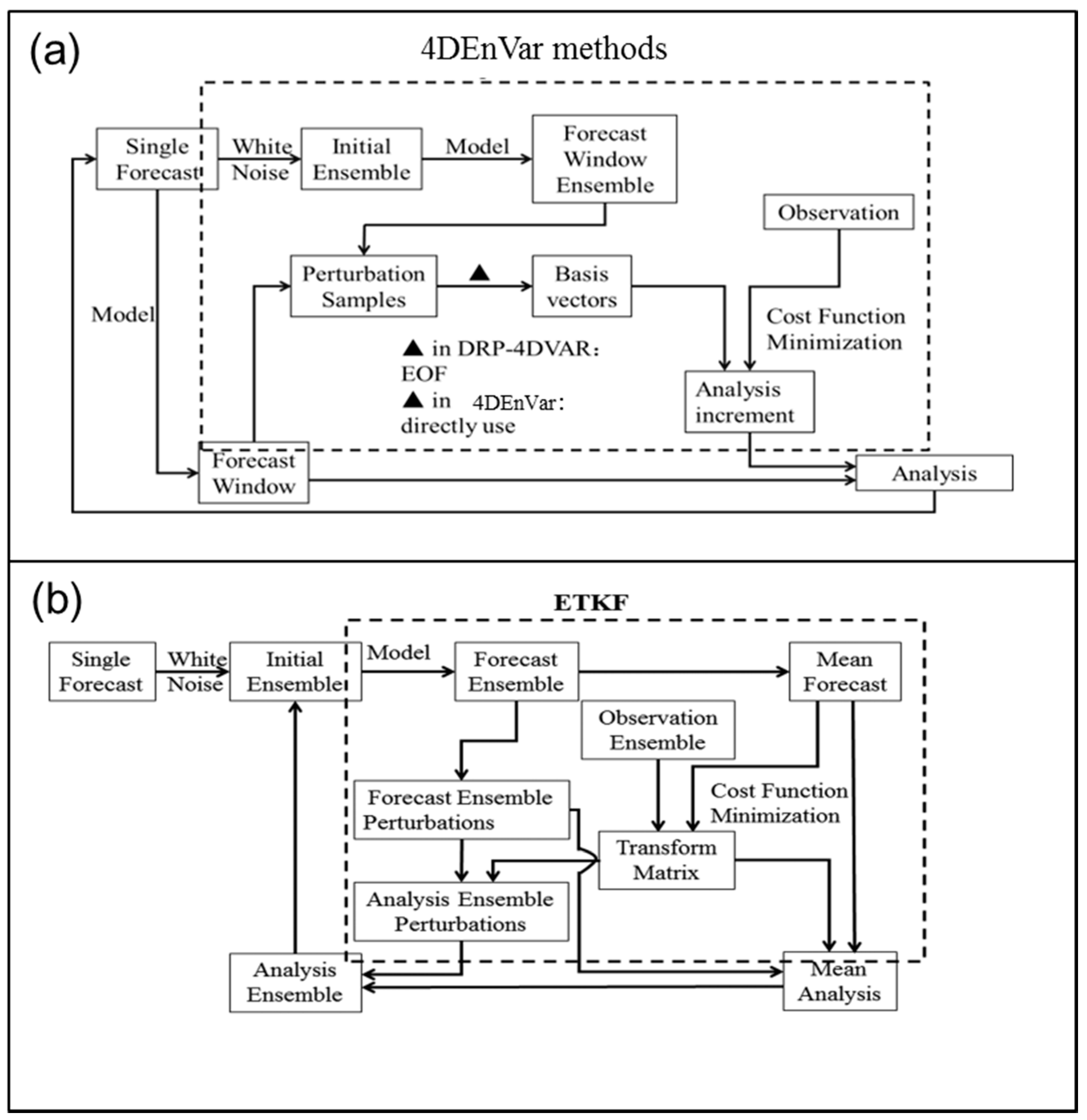


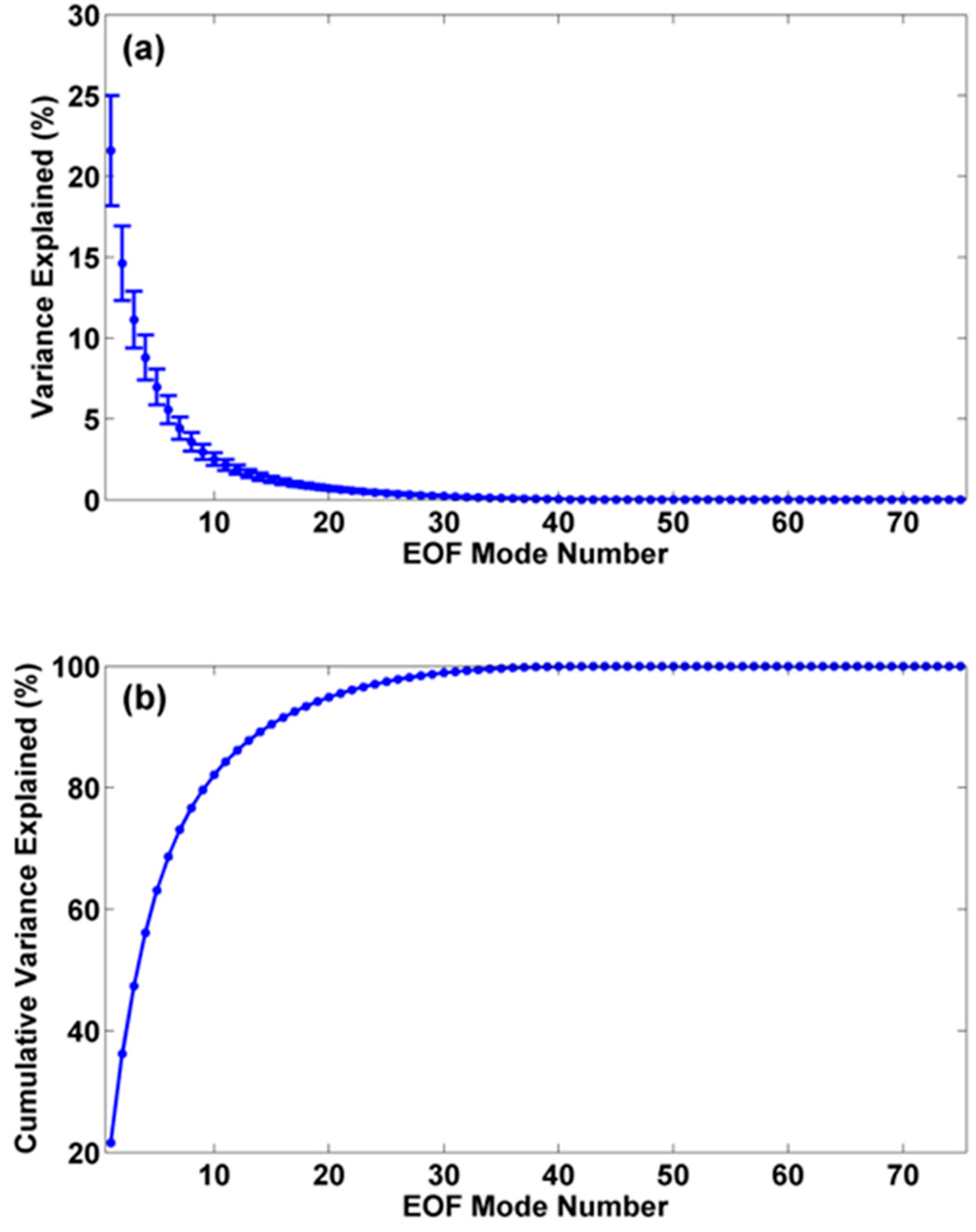
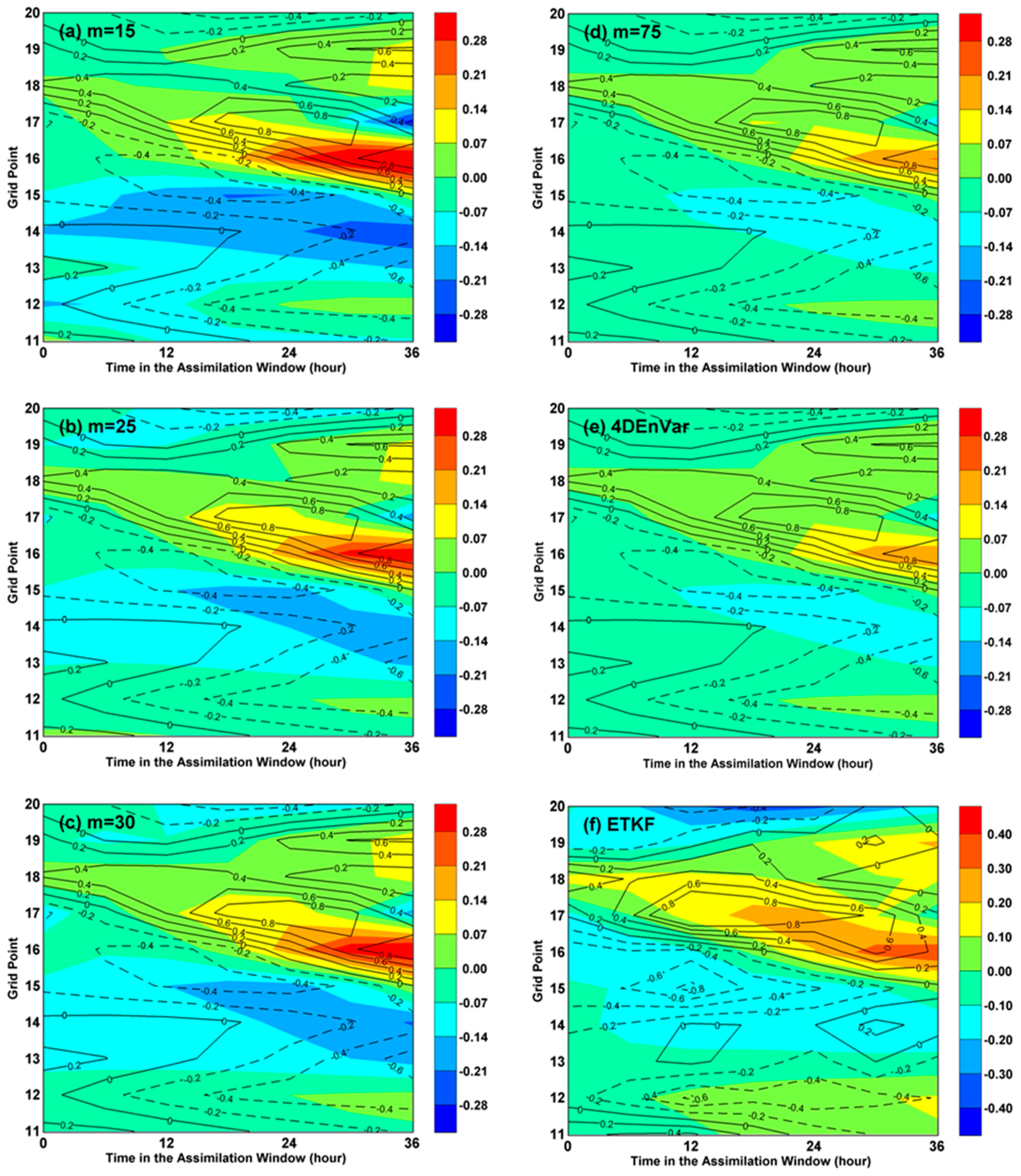
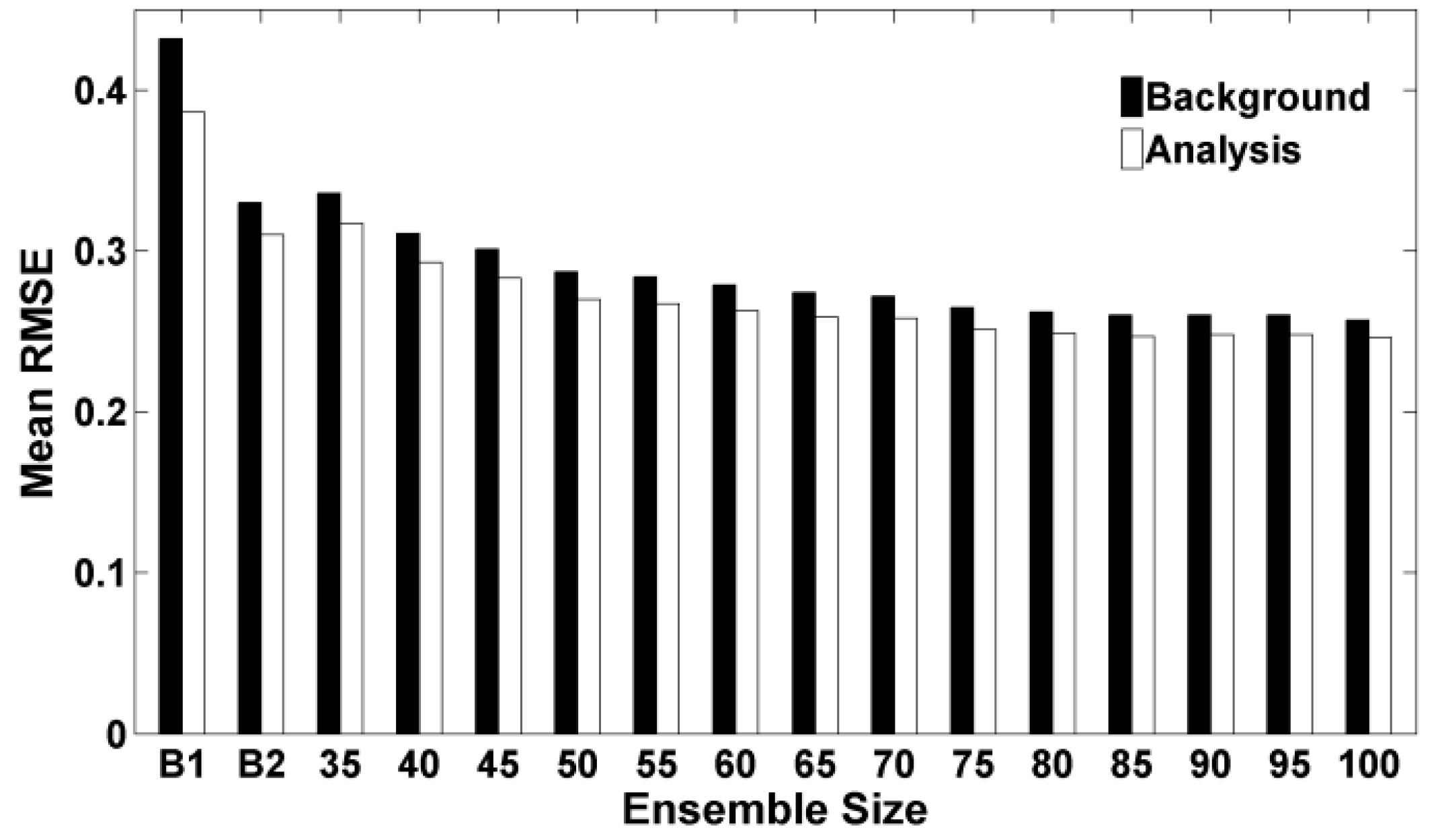
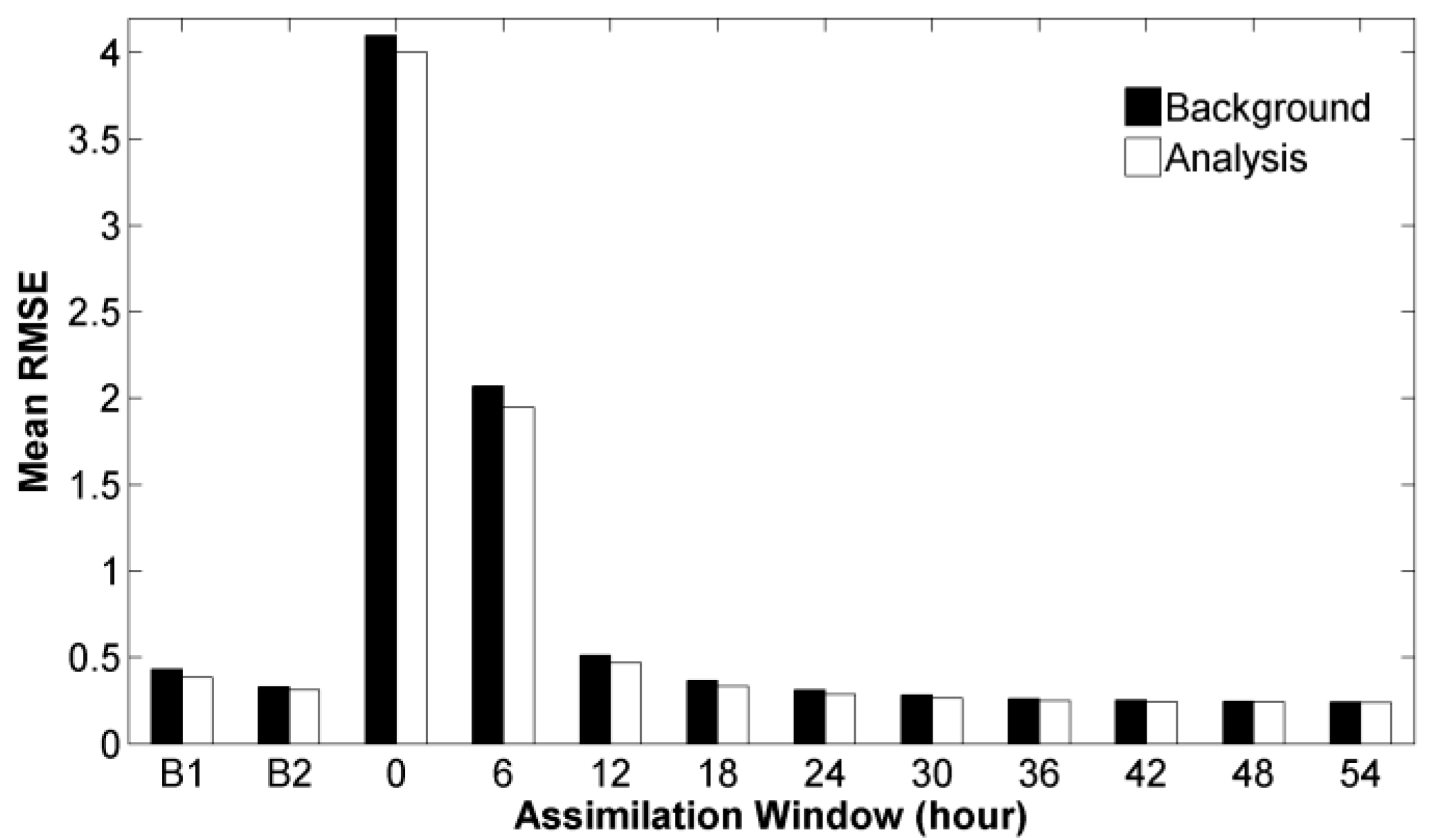
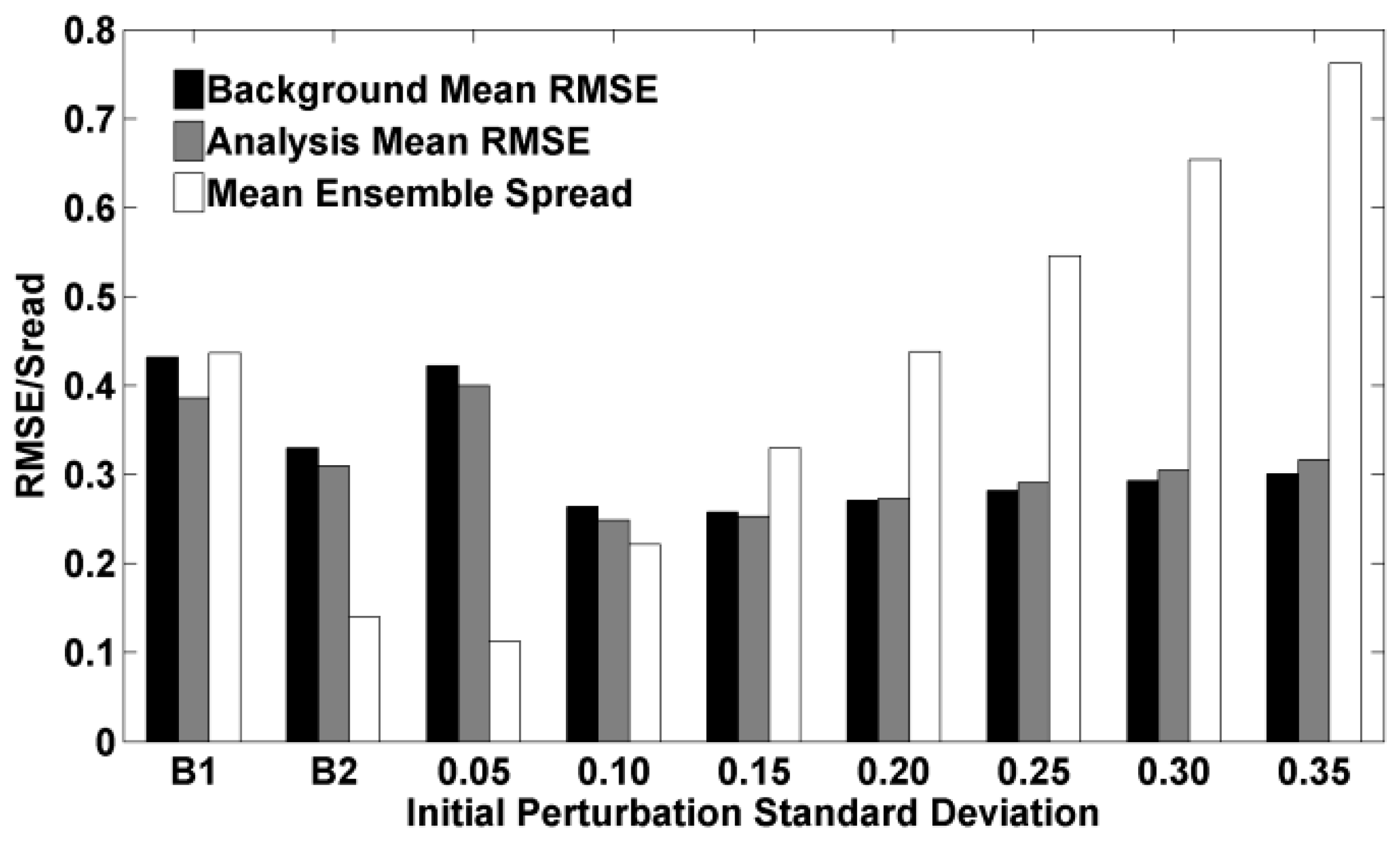
| Experiment | Sensitive Parameter | Parameter Setting |
|---|---|---|
| Exp-2 | EOF truncation number, | 5, 10, 15, 20, 25, 30, 35, 40, 45, 50, 55, 60, 65, 70, 75 |
| Exp-3 | Ensemble size, | 35, 40, 45, 50, 55, 60, 65, 70, 75, 80, 85, 90, 95, 100 |
| Exp-4 | Assimilation window length, (Unit: hour) | 0, 6, 12, 18, 24, 30, 36, 42, 48, 54 |
| Exp-5 | Standard deviation of initial random perturbation for each assimilation window, | 0.05, 0.10, 0.15, 0.20, 0.25, 0.30, 0.35 |
© 2017 by the authors. Licensee MDPI, Basel, Switzerland. This article is an open access article distributed under the terms and conditions of the Creative Commons Attribution (CC BY) license (http://creativecommons.org/licenses/by/4.0/).
Share and Cite
Kou, X.; Huang, Z.; Liu, H.; Zhang, M.; Shen, S.; Peng, Z. Evaluating the Role of the EOF Analysis in 4DEnVar Methods. Atmosphere 2017, 8, 146. https://doi.org/10.3390/atmos8080146
Kou X, Huang Z, Liu H, Zhang M, Shen S, Peng Z. Evaluating the Role of the EOF Analysis in 4DEnVar Methods. Atmosphere. 2017; 8(8):146. https://doi.org/10.3390/atmos8080146
Chicago/Turabian StyleKou, Xingxia, Zhekun Huang, Hongnian Liu, Meigen Zhang, Si Shen, and Zhen Peng. 2017. "Evaluating the Role of the EOF Analysis in 4DEnVar Methods" Atmosphere 8, no. 8: 146. https://doi.org/10.3390/atmos8080146
APA StyleKou, X., Huang, Z., Liu, H., Zhang, M., Shen, S., & Peng, Z. (2017). Evaluating the Role of the EOF Analysis in 4DEnVar Methods. Atmosphere, 8(8), 146. https://doi.org/10.3390/atmos8080146




